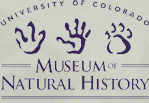 |
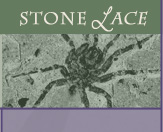 |
||
Page 4 To view larger versions of the images below, click on a thumbnail image or the specimen name. The larger version will display in a new browser window. Use the page number links below the images to go to the next page or return to a previous page. 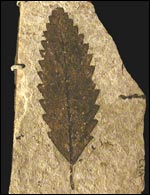 Fagopsis longifolia, Common Name: Beech (UCM #34605). Fagopsis longifolia is an extinct member of the beech tree family, one of the most common plants found at Florissant. Beech trees are found all over the world with the exception of Africa and southern Asia. Fagopsis longifolia, Common Name: Beech (UCM #34605). Fagopsis longifolia is an extinct member of the beech tree family, one of the most common plants found at Florissant. Beech trees are found all over the world with the exception of Africa and southern Asia. Liometopum miocenicum, Common Name: Velvety Tree Ant (UCM #2391). These ants are typically found in higher latitude locations today. They often have very large colonies that make their nests in the dead regions of living trees. They tend to be aggressive when defending their nests and will bite if they can get a hold of you! Liometopum miocenicum, Common Name: Velvety Tree Ant (UCM #2391). These ants are typically found in higher latitude locations today. They often have very large colonies that make their nests in the dead regions of living trees. They tend to be aggressive when defending their nests and will bite if they can get a hold of you! Osmylus columbianus, Common Name: Giant Lacewing (UCM #4103). These beautiful insects are members of the group that includes green lacewings and antlions. Both larvae and adults prey on other insects. They are not very good flyers and have a very fluttery appearance when on the wing. You can find giant lacewings today in more tropical regions of the world. Osmylus columbianus, Common Name: Giant Lacewing (UCM #4103). These beautiful insects are members of the group that includes green lacewings and antlions. Both larvae and adults prey on other insects. They are not very good flyers and have a very fluttery appearance when on the wing. You can find giant lacewings today in more tropical regions of the world.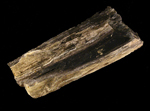 Sequoia affinis, Common Name: Redwood (petrified wood). This is a piece of one of the giant petrified stumps that are found at Florissant Fossil Beds National Monument. The outer surface of the fossil still shows the texture of the bark, and even the individual growth rings have been preserved. The stumps of the giant trees were preserved where they grew. The upper portions of the trees, which were not covered with silica rich volcanic ash and mud, decayed naturally and were not preserved. The stumps were a huge attraction to tourists passing through the Florissant area on steam engines in the late 1800s and early 1900s. Many of them were destroyed by people who wished to take a piece of the West home with them. Sequoia affinis, Common Name: Redwood (petrified wood). This is a piece of one of the giant petrified stumps that are found at Florissant Fossil Beds National Monument. The outer surface of the fossil still shows the texture of the bark, and even the individual growth rings have been preserved. The stumps of the giant trees were preserved where they grew. The upper portions of the trees, which were not covered with silica rich volcanic ash and mud, decayed naturally and were not preserved. The stumps were a huge attraction to tourists passing through the Florissant area on steam engines in the late 1800s and early 1900s. Many of them were destroyed by people who wished to take a piece of the West home with them.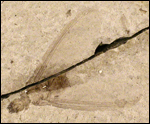 Hodotermes coloradensis, Common Name: Termite (UCM #16856). Termites feed on wood and members of this group focus on wood that is already dead and damp. Termites that reproduce have wings. In certain seasons they will leave the colony in large numbers. After they disperse, they shed their wings and begin a new colony. Termites are not very good flyers, which explains how they so easily become preserved in fossil lake settings. Hodotermes coloradensis, Common Name: Termite (UCM #16856). Termites feed on wood and members of this group focus on wood that is already dead and damp. Termites that reproduce have wings. In certain seasons they will leave the colony in large numbers. After they disperse, they shed their wings and begin a new colony. Termites are not very good flyers, which explains how they so easily become preserved in fossil lake settings. |

|
||
|
|
|||
|
|||
